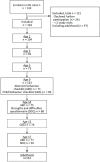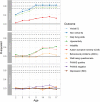Predicting Uncertain Multi-Dimensional Adulthood Outcomes From Childhood and Adolescent Data in People Referred to Autism Services
- PMID: 33633633
- PMCID: PMC7900001
- DOI: 10.3389/fpsyg.2021.594462
Predicting Uncertain Multi-Dimensional Adulthood Outcomes From Childhood and Adolescent Data in People Referred to Autism Services
Abstract
Introduction: Autism spectrum disorder is a highly heterogeneous diagnosis. When a child is referred to autism services or receives a diagnosis of autism spectrum disorder it is not known what their potential adult outcomes could be. We consider the challenge of making predictions of an individual child's long-term multi-facetted adult outcome, focussing on which aspects are predictable and which are not.
Methods: We used data from 123 adults participating in the Autism Early Diagnosis Cohort. Participants were recruited from age 2 and followed up repeatedly through childhood and adolescence to adulthood. We predicted 14 adult outcome measures including cognitive, behavioral and well-being measures. Continuous outcomes were modeled using lasso regression and ordinal outcomes were modeled using proportional odds regression. Optimism corrected predictive performance was calculated using cross-validation or bootstrap. We also illustrated the prediction of an overall composite formed by weighting outcome measures by priorities elicited from parents.
Results: We found good predictive performance from age 9 for verbal and non-verbal IQ, and daily living skills. Predictions for symptom severity, hyperactivity and irritability improved with inclusion of behavioral data collected in adolescence but remained modest. For other outcomes covering well-being, depression, and positive and negative affect we found no ability to predict adult outcomes at any age. Predictions of composites based on parental priorities differed in magnitude and precision depending on which parts of the adult outcome were given more weight.
Conclusion: Verbal and non-verbal IQ, and daily living skills can be predicted well from assessments made in childhood. For other adult outcomes, it is challenging to make meaningful predictions from assessments made in childhood and adolescence using the measures employed in this study. Future work should replicate and validate the present findings in different samples, investigate whether the availability of different measures in childhood and adolescence can improve predictions, and consider systematic differences in priorities.
Keywords: adult outcomes; autism spectrum disorder; childhood; early diagnosis cohort; prediction.
Copyright © 2021 Forbes, Lord, Elias and Pickles.
Conflict of interest statement
CL acknowledges the receipt of royalties from the sale of the Autism Diagnostic Observation Schedule (ADOS) and the Autism Diagnostic Interview-Revised (ADI-R). Royalties generated from this study were donated to a not-for-profit agency, Have Dreams. The remaining authors have declared that they have no competing or potential conflicts of interest.
Figures






Similar articles
-
The adult outcome of children referred for autism: typology and prediction from childhood.J Child Psychol Psychiatry. 2020 Jul;61(7):760-767. doi: 10.1111/jcpp.13180. Epub 2020 Jan 19. J Child Psychol Psychiatry. 2020. PMID: 31957035 Free PMC article.
-
Daily living skills in individuals with autism spectrum disorder from 2 to 21 years of age.Autism. 2015 Oct;19(7):774-84. doi: 10.1177/1362361315575840. Epub 2015 Apr 28. Autism. 2015. PMID: 25922445 Free PMC article.
-
Predictors of mental health and well-being in employed adults with autism spectrum disorder at 12-month follow-up.Autism Res. 2019 Mar;12(3):482-494. doi: 10.1002/aur.2064. Epub 2019 Jan 24. Autism Res. 2019. PMID: 30675764
-
Defining Positive Outcomes in More and Less Cognitively Able Autistic Adults.Autism Res. 2020 Sep;13(9):1548-1560. doi: 10.1002/aur.2359. Epub 2020 Aug 27. Autism Res. 2020. PMID: 32851813
-
Towards a fuller assessment of the economic benefits of reducing air pollution from fossil fuel combustion: Per-case monetary estimates for children's health outcomes.Environ Res. 2020 Mar;182:109019. doi: 10.1016/j.envres.2019.109019. Epub 2019 Dec 9. Environ Res. 2020. PMID: 31838408 Free PMC article.
Cited by
-
Ethical dimensions of translational developmental neuroscience research in autism.J Child Psychol Psychiatry. 2021 Nov;62(11):1363-1373. doi: 10.1111/jcpp.13494. Epub 2021 Aug 18. J Child Psychol Psychiatry. 2021. PMID: 34405894 Free PMC article. Review.
-
Longitudinal Analyses of Mental Health in Autistic Individuals: A Systematic Review.Brain Sci. 2024 Oct 18;14(10):1033. doi: 10.3390/brainsci14101033. Brain Sci. 2024. PMID: 39452045 Free PMC article. Review.
-
How do autistic people fare in adult life and can we predict it from childhood?Autism Res. 2023 Feb;16(2):458-473. doi: 10.1002/aur.2868. Epub 2022 Dec 15. Autism Res. 2023. PMID: 36519265 Free PMC article.
References
-
- Achenbach T. M., Rescorla L. A. (2001). Manual for the ASEBA School-Age Forms & Profiles. Burlington, VT: University of Vermont.
-
- Achenbach T. M., Rescorla L. A. (2003). Manual for the ASEBA Adult Forms & Profiles. Burlington, VT: University of Vermont.
-
- Aman M., Singh N. (1994). The Aberrant Behavior Checklist-Community. East Aurora, NY: Slosson Education Publications, Inc.
-
- Bagatell N. (2010). From cure to community: transforming notions of Autism. Ethos 38 33–55. 10.1111/j.1548-1352.2009.01080.x - DOI
LinkOut - more resources
Full Text Sources
Other Literature Sources

